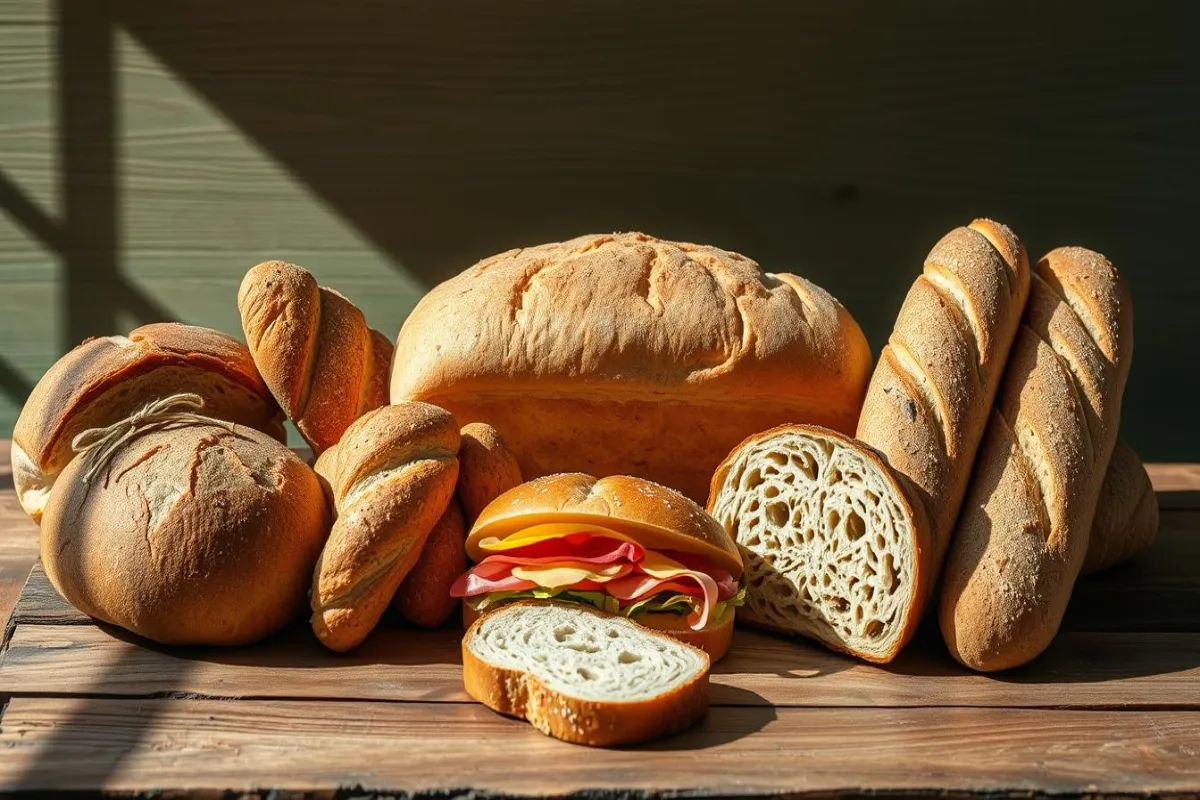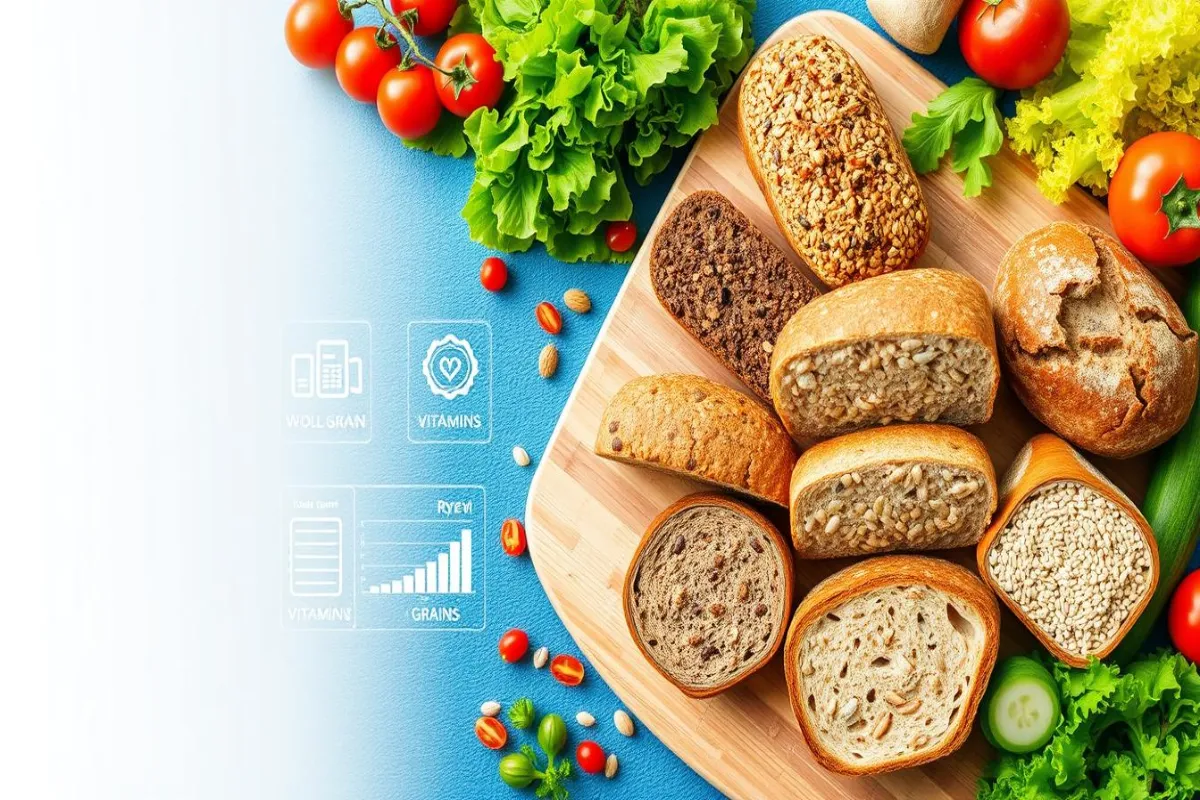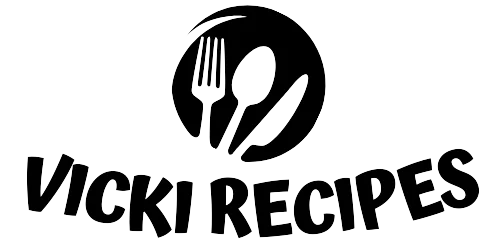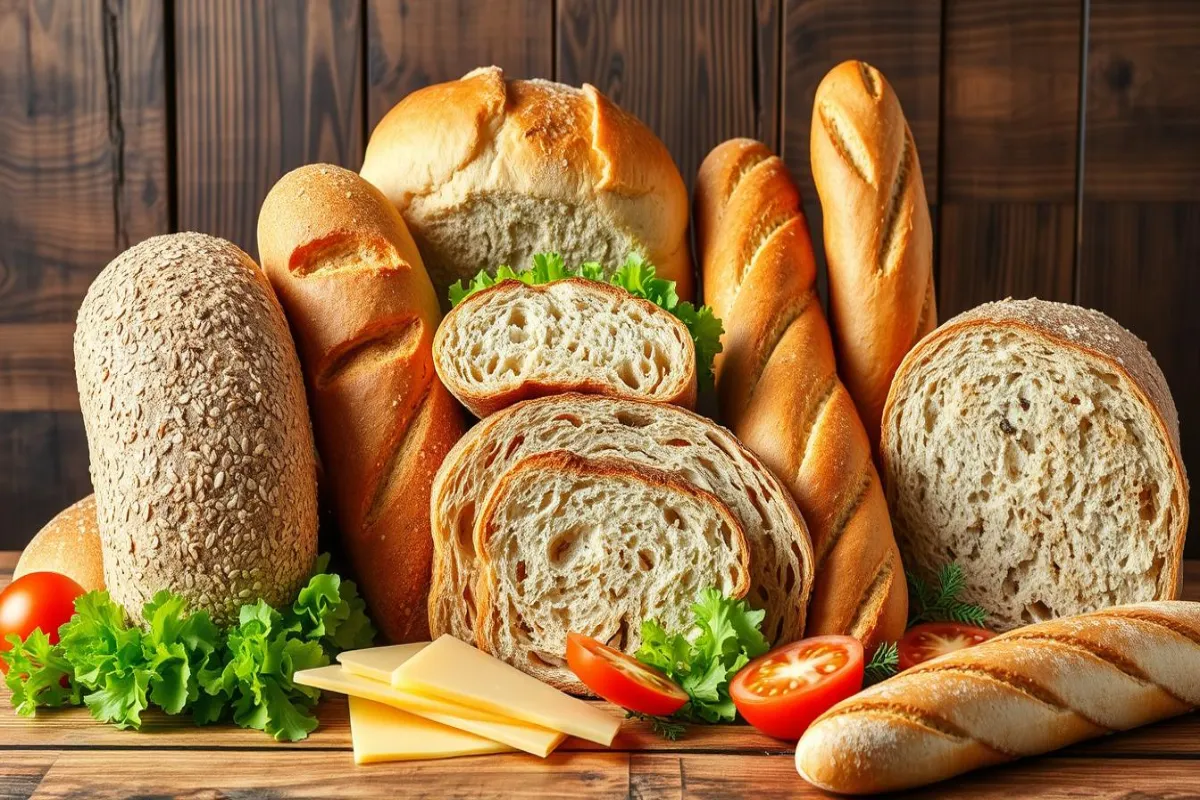Choosing the right bread is key to a great sandwich. The perfect bread can make your sandwich even better. It brings out the flavors and textures of your fillings. Let’s look at the top bread choices for your sandwiches, focusing on texture, taste, and nutrition.
Looking for a classic, healthy, or fancy bread? I’ve got you covered. We’ll cover everything from soft white to hearty whole wheat, and from tangy sourdough to multigrain with seeds. We’ll also talk about the nutritional side, like fiber, whole grains, sodium, and sugar.
By the end of this article, you’ll know the best bread for your sandwiches. You’ll be able to make tasty meals that will make you want more.
Sandwich Bread Types
When choosing sandwich bread, you often pick between white bread and whole wheat. Each has its own taste and texture. Knowing the differences helps you pick the right one for you.
Classic White Bread
White bread is known for being soft and light. It’s made from refined flour, which is less dense. This makes it a great base for sandwiches, letting the fillings shine.
Whole Wheat Bread
Whole wheat bread is denser and more filling. It keeps the bran and germ of the wheat. This makes it healthier, with more fiber and nutrients.
Choosing between white and whole wheat bread depends on what you like and need. Both have their benefits, so it’s about finding what’s best for you.
| Characteristic | Classic White Bread | Whole Wheat Bread |
|---|---|---|
| Texture | Soft and light | Hearty and substantial |
| Flavor | Mild and unobtrusive | Nutty and earthy |
| Nutritional Profile | Lower in fiber and nutrients | Higher in fiber, vitamins, and minerals |

Choosing between white and whole wheat bread is a personal decision. Both can be great for your sandwiches, depending on what you like and need.
Nutritional Considerations
Choosing the right sandwich bread is key. It should offer essential nutrients, fiber, and whole grains. These help fuel your body and keep you full. But, breads with too much sodium and added sugars are not as good for you.
Fiber and Whole Grains
Whole grain breads, like whole wheat and multigrain, have more fiber than white bread. Fiber is good for your digestion and keeps you full longer. Choose breads where “whole wheat” or other whole grains are the first ingredient for the best nutrition.
Sodium and Sugar Content
Even “healthy” breads can have a lot of sodium and added sugars. Too much sodium can raise blood pressure, and added sugars add calories without nutrients. When picking a healthiest sandwich bread, look for options with less than 140mg of sodium and no more than 2-3 grams of added sugar per slice.
| Nutrient | Whole Wheat Bread | White Bread |
|---|---|---|
| Fiber (g per slice) | 3 | 1 |
| Sodium (mg per slice) | 120 | 170 |
| Added Sugars (g per slice) | 1 | 2 |
By picking breads with good nutrition, you make healthier sandwich options. This is true whether you’re making a bread for subs or a classic deli sandwich. Remember, the nutrition of bread matters a lot.

Texture and Mouthfeel
The perfect sandwich starts with the bread’s texture and mouthfeel. A toasted crust adds a satisfying crunch, while fresh bread is soft and fluffy. This texture can make your sandwich experience better.
The bread’s crumb is key to its texture. A tight crumb feels smooth, while an airy one is light. The crust’s crispness or softness also affects the sandwich’s feel.
Chewiness is another important aspect. Chewy bread adds a satisfying feel, while soft bread is better for delicate fillings.
| Bread Texture Attribute | Description | Ideal Sandwich Pairings |
|---|---|---|
| Tight, Fine-Grained Crumb | Smooth, velvety mouthfeel | Deli meats, cheese, delicate fillings |
| Open, Airy Crumb | Light, fluffy texture | Hearty fillings, grilled sandwiches |
| Chewy Texture | Substantial, satisfying feel | Robust fillings, toasted sandwiches |
Finding the right bread for your sandwich depends on the fillings and your taste. Try different breads to find your perfect match.
“The bread is the foundation of the sandwich, and its texture can make or break the entire experience.”
What is the best bread to use for a sandwich?
Choosing the right bread is key to a great sandwich. The bread’s type can greatly affect the sandwich’s taste and feel. I’ve picked the top breads for a sandwich, based on taste, nutrition, and how well they hold up.
My top picks are whole wheat, sourdough, and multigrain. These breads offer great taste, nutrition, and structure. They can make any sandwich better.
- Whole Wheat Bread: It’s full of fiber and complex carbs, making it a hearty choice. Its nutty flavor goes well with many fillings, from meats to veggies.
- Sourdough Bread: Known for its tangy taste and chewy texture, sourdough is a hit. Its unique flavor works well with both savory and sweet fillings.
- Multigrain Bread: It’s a nutritious and attractive option. With whole grains, seeds, and nuts, it adds crunch and fiber, plus vitamins and minerals.
Think about taste, texture, and nutrition when picking bread. Look for whole grains, fiber, and less sugar and salt for a healthier sandwich.
| Bread Type | Nutritional Benefits | Flavor Profile | Texture |
|---|---|---|---|
| Whole Wheat | High in fiber, complex carbohydrates, and various vitamins and minerals | Nutty, earthy | Hearty, substantial |
| Sourdough | Contains probiotics and may be easier to digest for some individuals | Slightly tangy, unique fermented flavor | Chewy, crusty |
| Multigrain | Rich in fiber, vitamins, and minerals from the blend of whole grains | Nutty, slightly sweet | Crunchy, with a variety of textures |
The best bread for your sandwich depends on what you like and what you’re aiming for. Try different breads to find your perfect match.
Bread Freshness and Shelf Life
The freshness and shelf life of a sandwich bread are key to its quality and taste. Knowing how preservatives, additives, and storage affect a bread’s texture and flavor is important. This is especially true for those who love making sandwiches.
Preservatives and Additives
Manufacturers use preservatives and additives to keep bread fresh longer. Ingredients like calcium propionate and sorbic acid stop mold and bacteria from growing. This helps the bread stay soft and fresh for longer.
But, some people might choose bread with fewer preservatives. They might prefer bread made with natural ingredients and processes. This way, they can enjoy bread that’s fresh without additives.
Storing bread right is also crucial for keeping it fresh. Keep it at room temperature, away from sunlight and heat. This helps it stay soft and flavorful. Refrigerating bread can make it dry and stale, so it’s best to avoid it unless it’s already sliced and needs to stay fresh for a while.
The right mix of preservatives, additives, and storage can make a big difference. It affects how long a sandwich bread stays fresh and how good it tastes. When picking bread for sandwiches, think about what you like and what you need.
Sandwich Fillings and Bread Pairings
Choosing the right bread for your sandwich is key to a great meal. Whether you prefer meat and cheese or veggie sandwiches, the bread matters a lot. It affects the taste and texture of your sandwich.
Meat and Cheese Sandwiches
For meat and cheese sandwiches, like turkey or ham, choose sturdy bread. Sourdough or whole wheat is perfect. Their chewy texture and nutty flavors balance well with the fillings.
Soft white bread is also great. It lets the meat and cheese take center stage, offering a neutral base.
Veggie and Hummus Sandwiches
For veggie or vegan sandwiches, go for lighter bread. Whole grain breads like multigrain or seeded are ideal. They add texture and flavor that complements the veggies and hummus.
For a richer taste, try focaccia or ciabatta. They offer a sturdy yet airy base for your veggie and hummus sandwiches.
| Sandwich Fillings | Recommended Bread Types |
|---|---|
| Meat and Cheese | Sourdough, Whole Wheat, White Bread |
| Veggie and Hummus | Multigrain, Seeded, Focaccia, Ciabatta |
Exploring different bread and filling combinations can lead to amazing sandwiches. By picking the right bread, you can make a meal that’s both harmonious and satisfying.
Artisan and Specialty Breads
There’s more to bread than just white and whole wheat. Let’s dive into the world of artisan and specialty breads. These options can take your sandwiches to the next level. We’ll look at sourdough, multigrain, and seeded breads, perfect for gourmet sandwiches.
Sourdough Bread
Sourdough bread is known for its tangy taste and chewy texture. It’s made with a slow fermentation process. This makes it easier to digest and full of good probiotics.
It also has a lower glycemic index. This is great for those watching their carb intake.
Multigrain and Seeded Breads
Multigrain and seeded breads add nutrition and an artisan touch to sandwiches. They mix whole grains like wheat, rye, oats, and barley. Plus, they include seeds like sunflower, flax, and sesame.
This creates a hearty, flavorful bread. It’s packed with fiber, protein, and vitamins and minerals.
Whether you’re making an artisan bread for sandwiches, trying sourdough vs. whole wheat, or seeking gourmet sandwich options, these breads open up new possibilities. They can make your lunchtime meal even better.
“A good sandwich is a work of art, a time-honored fusion of flavors united between two slices of bread.”
Bread for Subs and Grinders
Choosing the right bread is crucial for a great sandwich. This is especially true for subs and grinders. They need bread that can handle the weight and volume of their fillings.
The bread must stay strong under the weight of meats, cheeses, and veggies. It should not get soggy or fall apart.
The bread’s texture is also key. It should be soft inside and crisp outside. This mix gives the sandwich the right balance of comfort and support.
| Bread Type | Ideal for Subs and Grinders? | Key Features |
|---|---|---|
| Italian or French Bread | Yes | Sturdy, with a crisp crust and a soft, chewy interior |
| Hoagie or Sub Rolls | Yes | Elongated shape and firm texture to support hearty fillings |
| Focaccia | Yes | Soft, airy texture and savory flavor profile |
| Ciabatta | Yes | Crisp crust and light, open crumb structure |
When picking the best bread for subs and grinders, think about the flavors and textures you want. The right bread can turn a simple sandwich into a memorable treat.
Gourmet and Upscale Sandwich Options
Exploring artisan breads can make your sandwich experience unforgettable. Focaccia and ciabatta are top picks that can take your sandwich to the next level. These breads add unique textures and flavors, turning a basic sandwich into a gourmet treat.
Focaccia and Ciabatta: Artisan Bread for Sandwiches
Focaccia is a soft, chewy Italian flatbread with a dimpled surface. It has a slightly salty, herb-infused taste that goes well with many fillings. Its sturdy yet soft texture holds up to hearty ingredients without getting soggy.
Ciabatta, an airy Italian bread, has a crisp crust and a light interior. Its mild flavor lets the fillings stand out, while its structure offers a satisfying bite. It’s perfect for gourmet sandwich options, supporting everything from seafood salads to roast beef.
Both focaccia and ciabatta bring special bread texture and flavor to your sandwiches. Try them out to find your ideal gourmet sandwich options.
Personal Preferences and Dietary Needs
Choosing the healthiest sandwich bread depends on personal taste and dietary needs. For those who are gluten-free, finding good bread can be tough. But, there are now many tasty and healthy gluten-free options. Vegans and vegetarians also have more plant-based bread choices than before.
Gluten-Free and Vegan Options
People with gluten sensitivities or celiac disease have great bread choices. Breads made from gluten-free grains like quinoa, rice, or healthiest sandwich bread such as buckwheat are excellent. They taste and feel like traditional wheat bread, making it easy to find bread and filling combinations.
- Gluten-free breads made from rice, quinoa, or buckwheat
- Vegan breads made from plant-based ingredients like nut or seed flours
- Artisan gluten-free and vegan options for a more premium sandwich experience
Vegans and those on plant-based diets have a wide range of gluten-free and vegan options for sandwich bread. These are often made from nut or seed flours. They offer a nutritious base for many fillings and toppings.
“Finding the right bread is essential for creating a delicious and healthiest sandwich bread that caters to your personal preferences and dietary needs.”
Whether you prefer traditional wheat bread or are looking for gluten-free and vegan options, there’s a wide selection. You can now make the perfect sandwich that meets your individual needs.
Conclusion
The “best” bread for your sandwich depends on what you like, your diet, and the flavors you want. You can choose from white, whole wheat, or sourdough. There are many options to try.
Think about the bread’s texture, nutrition, and freshness. This helps you pick the perfect bread for your sandwich. Whether it’s a simple sandwich or something fancy, the right bread makes it special. The sandwich bread types let you make your meal just right.
Keep trying new breads to find the best bread to use for a sandwich. The perfect bread is out there, waiting for you to find it and enjoy it.
FAQ
What is the best bread to use for a sandwich?
Choosing the best bread for a sandwich depends on what you like and need. Think about the texture, nutrition, and taste. These factors help pick the perfect bread for your sandwich.
What are the different types of sandwich bread?
Common sandwich breads include white, whole wheat, sourdough, multigrain, and specialty ones like focaccia and ciabatta.
What are the nutritional considerations when choosing a sandwich bread?
Look at the bread’s fiber, whole grains, sodium, and sugar content. Whole grain and high-fiber breads offer lasting energy. Choose low sodium and sugar for a healthier option.
How does the texture and mouthfeel of a bread impact the sandwich experience?
The bread’s texture and feel can change how you enjoy your sandwich. Crumb structure, crust, and chewiness all matter. They affect the taste and feel in your mouth.
What is the best bread to use for a sub or grinder sandwich?
For subs and grinders, pick breads with a strong crust. They should hold up to filling without getting soggy.
What are some gourmet and upscale sandwich bread options?
For fancy sandwiches, try focaccia, ciabatta, or artisanal sourdough. These breads add unique flavors and textures. They pair well with many fillings.
How does bread freshness and shelf life impact the sandwich experience?
Freshness and shelf life matter a lot. Preservatives, additives, and how you store it affect the bread’s texture and taste.
How do different bread types pair with common sandwich fillings?
The right bread can enhance your sandwich. Some breads match well with meats and cheeses. Others are better with veggies and spreads.
What are some gluten-free and vegan sandwich bread options?
There are many gluten-free and vegan breads for sandwiches. They let everyone enjoy a tasty, handheld meal, even with dietary restrictions.

